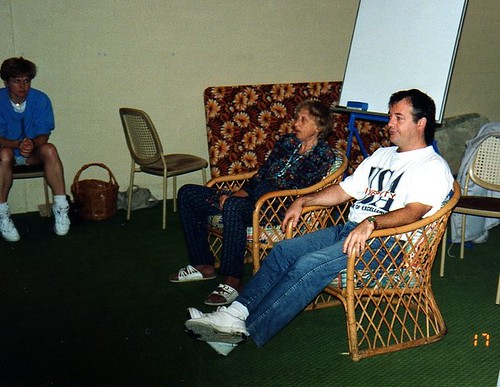Tuesday, April 2, 2013
My golden rule of therapy
Thursday, January 10, 2013
The psychology of danger
Sunday, November 11, 2012
The machinations of developmental psychological theory
Friday, October 5, 2012
Psychology 101 and suicide
Saturday, January 29, 2011
People’s expectations
The glasses, the solarized effect and the apparently odd manner of my presentation on a serious topic like panic attacks. People apparently who know me or have seen my work as a psychologist in some way expect a video presentation of a more ‘professional’ style. So I get asked why did I do it like that? To which I answer, there is an old rule of psychotherapy - don’t give people what they expect. Its really a rule of human communication in general - don’t give people what they expect.
After they hear this explanation they seem to be satisfied because no more is said or asked by them. This has struck me as a bit odd because my answer I think begs another question - why not?
Why not give people what they expect?

If anyone ever asked me this I am not sure what I would answer. My first thought is that it would depend on the situation where the unexpected communication occurred. In psychotherapy I think it certainly has its place. If a client comes to therapy they will have an expectation of what is going to happen what they will say, what I will say and so forth.
If they leave with what they expected then the session was OK to average, to not much good. If the person gets what they did not expect in the session then it is much more likely that the session was more effective. Of course not every session a client attends can provide some kind of profound epiphany. But in the overall approach there needs to be at times unexpected communications by the therapist.
This will stop the therapy becoming routine. In one way psychotherapy is about unbalancing the client or putting them in a state of disequilibrium. They enter therapy with a psyche or psychological makeup that is a functional whole. That functional whole may be causing them pain but it still is a functional whole. If therapy can destabilise that functional system then the parts of that system are more able to be rearranged such that a new structure is obtained. That new structure can then lead to less pain being experienced by the individual. It seems reasonable to conclude that if the client gets something they did not expect then that will have a destabilised effect.

Society is like personality. Revolution destabilzes it. Once done then change is more likely to occur. Psychotherapy can be seen as creating a revolution in the personality.
Another reason is something far less ethereal and recondite. It gets the Free Child of the client into the room and that is something you certainly want in therapy. If that video was of me standing there is psychotherapist type clothing, in a psychotherapist type manner in front of a white board with a pointer what ego states of the viewer are going to be elicited. Probably Adult with maybe some interested Child if the topic of panic attacks was of interest.
Because of my presentation I would suggest that much more Child ego state in the viewer is elicited. First they are far more likely to remember it than if it was done in the other way. As indeed would happen in a therapy session if something unexpected happened. If I can get the client’s Free Child into the communications with me that is a very good thing for a successful outcome for the session.

However we now have another problem. Because I have let out one of my trade secrets people will now begin to expect the unexpected. Thus we end up back to where we were before.
However there are ways and means to deal with these things and I can’t tell all my trade secrets. Well not all at once.
Graffiti
Wednesday, September 2, 2009
The psychology of the bitch **
They passed me quite slowly in the first aisle and I overheard what they were saying. I wasn’t going out of my way to eaves drop on them! They were just talking and it was quite close as we passed each other. They would have been in their 50s and they were talking about some other woman who obviously had small children.
Well! They were savaging her, they were tearing her to shreds. A full on character assassination it was. Firstly about how bitchy she could be. Which was a bit ironic as they were bitching about her bitchiness. Then when we crossed two aisles later they were still at her, about what a bad mother she was, how she never controlled her children, always let them run amok and so forth.

So I wondered about all that. What was all that about? Why did it happen?
I suppose one could see it as a display of anger or aggression. Of all the emotions, it would seem that anger is the one that it would most closely be aligned to. However it is the expression of aggression in a feminine way - that is verbally. I think one could say that the more masculine expression of aggression would be less verbal and more physical.
So one could say that bitching can be a form of feminized aggression. Thus explaining why women (and gay guys) tend to engage in it more than straight males do, or at least one could argue that.

However since musing on this topic I have had discussions with two female colleagues of mine. They came up with some ideas that as a male I had not understood or even considered. They said that for females sometimes bitching about someone allows for a connection to be made between the two discussants. To say such confidential thoughts and secrets to the other means that you are trusting them and taking the relationship to a deeper level sort of thing. A most interesting idea that as a male one does not tend to experience at all. In this way the psychology of bitching is about relationship formation and maintenance.
I would suggest that males are not so bitchy in these ways but males certainly can be competitive. Whilst that is about winning and beating the other it is not so much about putting the other person down or creating some sort of connection between two men.
There is one other point that I would like to mention. In the Transactional Analysis literature one comes across the concept of four life positions:
I’m OK, You’re OK - (I+U+)
I’m not OK, You’re OK - (I-U+)
I’m OK, You’re not OK - (I+U-)
I’m not OK, You’re not OK - (I-U-)
I have since developed the theory of life positions further and this can be found at Life Positions.

I think one could say that the bitch would be adopting the life position of
I’m OK, You’re not OK - (I+U-)
In the article I state that it is more accurate to conceptualise this life position as:
I’m not OK, but You’re worse (I-U--)
The person in this position does not feel OK about self (I’m not OK). They deal with this is by trying to prove to self that others are worse than them. If they can prove such a thing then they feel better about self. It would seem reasonable to hypothesise that at least for some, this is one of the psychological functions of bitching.
“If I can prove to myself that some one else is bad, not doing the right thing and so forth then I wont feel so bad about myself” is the thinking of the bitch.
Now this formulation provides for an interesting theoretical off shoot. This last psychological function of bitching could be seen as a defence mechanism as was conceived of by Freud. The goal of the defence mechanism is to fend off anxiety provoking threats to the person. The belief - I’m not OK - would be such an anxiety provoking threat that the person would seek to fend off using one of the defence mechanisms.

To my knowledge no such defence mechanism like bitching has been previously suggested. There is a defence mechanism called - self negation. In this case the person wards off anxiety by getting in first with self criticisms and derogatory remarks. This is done in the hope that others will refute such claims with comments like - “Oh you’re not silly at all”.
Bitching could be seen as a derivative of this. It is not self negation, but others negation. By negating others the focus of attention is taken off self and this fends off the anxiety about ones own self doubts. In addition by convincing self that others a very negative then one’s own negative characteristics are minimised. Again the anxiety provoking threat is fended off.
So perhaps we need to add to Freud’s list of defence mechanisms with - The bitch defence mechanism.
Graffiti
Sunday, June 28, 2009
Monologue on emotional neglect
Saturday, June 27, 2009
Trauma management **
The previous post on a model for trauma debriefing relates to only one type of trauma. That is either single incident trauma or an ongoing trauma that has since ceased.
Single incident trauma is just that, a single incident. Examples may be an abduction, serious car accident, airline or train accident, an assault or rape, or some life threatening incident such as a terrorist bombing. Usually these are unpredictable, occur quickly and then end in a relatively short space of time. That is they do not continue over weeks or months or years. It is not uncommon to get clients with this type of traumatic experience presenting for treatment.

Indeed the research indicates that it is best to begin the debriefing process within 72 hours of the event occurring, if that can be arranged. If the debriefing does not occur within 6 weeks then it is seen that the personality adjusts and incorporates the traumatic reactions into it. Thus the reactions become ego syntonic and do not remain ego dystonic and thus they are harder to remedy.
The model described below is particularly relevant to this type of trauma . I would suggest however that most trauma is not of this kind. Most often the traumatic event(s) extend over a prolonged period of time and involve a whole series of single traumatic events collected together. So one ends up with not a single traumatic event but a period of time where there was a number of traumatic events collected together.

Examples of this may include ongoing legal battles, marital problems, bullying, imprisonment, difficult pregnancy, protracted life threatening illness, political harassment and can occur in some occupations such as in the military, the police or the ambulance service.
The model described below is relevant for these ongoing trauma periods as long as it is definitely over. For instance the person has left the military, the marriage is over, the baby has been born healthy, or the legal battles or bullying have ended. One can then set about resensitizing the Free Child again using the model described before.

Not uncommonly however a therapist will be dealing with a client who is in the middle of a series of traumatic events and not at the end of it. Such as employees who are sent for counselling because they are on stress leave from work. In such circumstances the therapist is not suggesting trauma debriefing. Even if they did it would not happen because the Free Child of the client simply will not go there. As mentioned before the FC has partitioned itself off and it simply will not even consider coming out of hiding until it sees that the environment is no longer threatening like is has been.

Balancing act
The therapist does not seek to resensitize the Free Child like described before. One does not do trauma debriefing but instead does trauma management and this can require some therapeutic skill at times. One walks that fine line with the client between assisting the Free Child to hide but also wanting the Free Child to be resensitized enough so as to avoid some of the PTSD symptoms that will develop is the Free Child hides too deep for too long.
Graffiti












